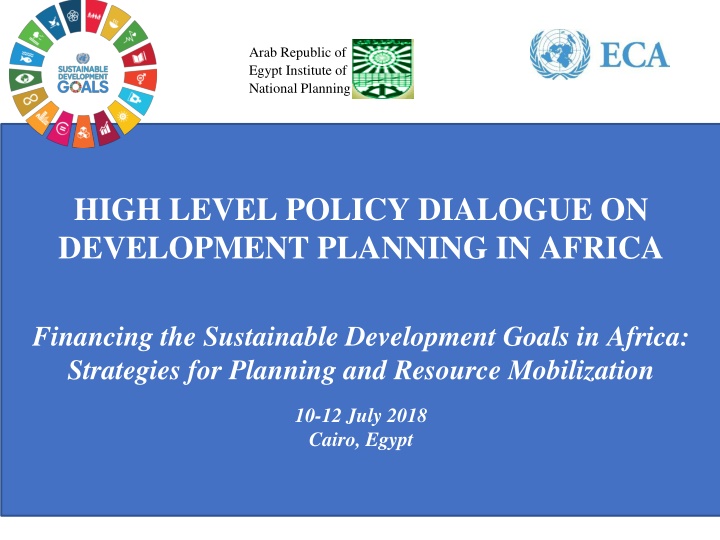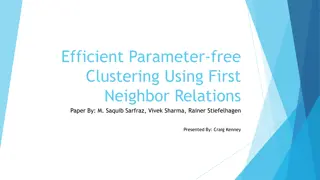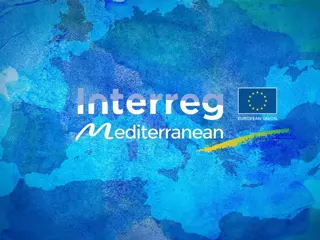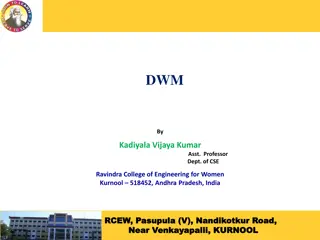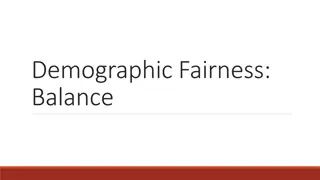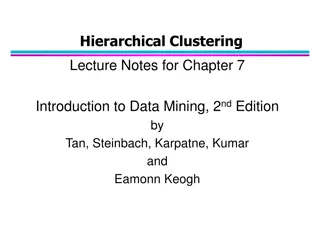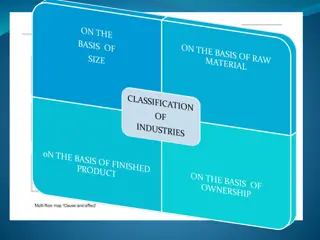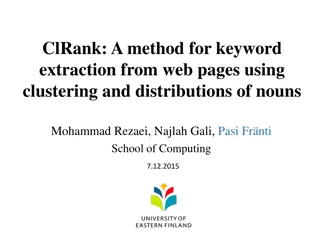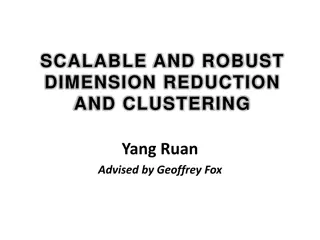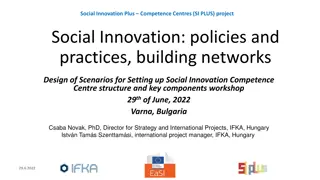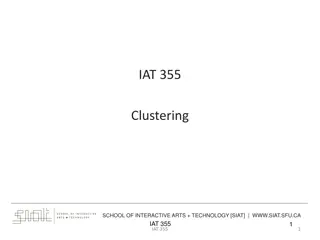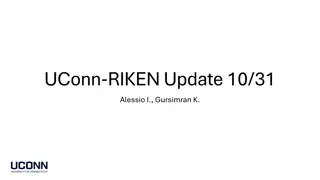International Seminar on Innovation and Clustering in Creative Industries
The TALIA project, part of the Interreg MED programme, focuses on enhancing the social and creative community by supporting projects in Culture and Creative Industries (CCI). With a mission to promote cohesion and synergies, TALIA aims to unify networks, exchange experiences, and share policy recommendations across a variety of innovative projects in the field. Current projects under TALIA's focus include CHIMERA, Co-Create, CoWorkMed, CreativeWear, and Open DOORS. These projects explore topics such as innovative clusters, coworking hubs, sharing economy, and public procurement of innovation.
Download Presentation

Please find below an Image/Link to download the presentation.
The content on the website is provided AS IS for your information and personal use only. It may not be sold, licensed, or shared on other websites without obtaining consent from the author.If you encounter any issues during the download, it is possible that the publisher has removed the file from their server.
You are allowed to download the files provided on this website for personal or commercial use, subject to the condition that they are used lawfully. All files are the property of their respective owners.
The content on the website is provided AS IS for your information and personal use only. It may not be sold, licensed, or shared on other websites without obtaining consent from the author.
E N D
Presentation Transcript
Arab Republic of Egypt Institute of National Planning HIGH LEVEL POLICY DIALOGUE ON DEVELOPMENT PLANNING IN AFRICA Financing the Sustainable Development Goals in Africa: Strategies for Planning and Resource Mobilization 10-12 July 2018 Cairo, Egypt
Overview 1- Introduction 2- The economic context and implications for financing the SDGs 3- Linking development planning and financing 4- Funding requirements and gaps 5- Funding sources 6- Challenges to SDGs Financing 7-Challenges to SDGs Financing: Illicit Financial Flows Status and achievement of Goal 17 www.uneca.org/arfsd2018 8- Concluding Remarks 2
HLPD ON DEVELOPMENT PLANNING IN AFRICA Introduction Key recommendation of the 2017 HLPD in Abuja: Need to strengthen African countries capacities to develop effective resource mobilization strategies in support of integration of SDGs in National Development Plans The AAAA of the Third International Conference on FFD of July 2015 provides a global framework for financing sustainable development It is imperative for African countries to take stock of the financing requirements and the range of funding sources and instruments for not only the SDGs, but Agenda 2063 as well. The mobilization of resources, their effective allocation and utilization are essential. To this end, there is a need to design a resource mobilization framework for financing SDGs in Africa. Status and achievement of Goal 17 www.uneca.org/arfsd2018 3
HLPD ON DEVELOPMENT PLANNING IN AFRICA Overview of Recent Macroeconomic Developments in Africa Status and achievement of Goal 17 www.uneca.org/arfsd2018 4
Overview of recent macroeconomic developments in Africa Average annual GDP growth in Africa, by sub region (%) 7 6 5 4 3 2 1 0 2014 2015 2016 2017* 2018** 2019** Africa Central Africa East Africa North Africa Southern Africa West Africa Source: African Development Bank Group (2018) African Economic Outlook (2018) * estimated ** projected Status and achievement of Goal 17 www.uneca.org/arfsd2018 5
Overview of recent macroeconomic developments in Africa Current account balance, (%) of GDP 15.0 10.0 5.0 0.0 -5.0 -10.0 -15.0 Africa East Africa Central Africa North Africa Southern Africa West Africa Source: UNCTADstat (2018) Status and achievement of Goal 17 www.uneca.org/arfsd2018 6
Overview of recent macroeconomic developments in Africa Fiscal deficit position in Africa, 2015 2018 2015 2016 2017e 2018f 0 -2 Budget balance (% GDP) -4 -6 -8 -10 -12 -14 -16 -18 Africa North Africa East Africa Southern Africa West Africa Central Africa Source: ECA calculations based on 2017 data from the Economist Intelligence Unit database, see www.eiu.com. Note: e refers to estimates; f refers to forecasts. Status and achievement of Goal 17 www.uneca.org/arfsd2018 7
Overview of recent macroeconomic developments in Africa Inflation by sub-region, (%) 2015-2018 16.0 14.0 12.0 10.0 8.0 6.0 4.0 2.0 0.0 2014 2015 2016 2017* 2018** 2019** Africa Central Africa East Africa North Africa Southern Africa West Africa Source: Data extracted from African Development Bank Group (2018) African Economic Outlook 2018 * estimated ** projected Status and achievement of Goal 17 www.uneca.org/arfsd2018 8
HLPD ON DEVELOPMENT PLANNING IN AFRICA Development Planning and SDGs Financing Status and achievement of Goal 17 www.uneca.org/arfsd2018 9
Development Planning and SDGs Financing Planning is a critical exercise that helps to shape a country s development goals and priorities. For the SDGs, long-term planning is imperative to better understand financing requirements for sustainable development Financing the SDGs implies need to ensure coherence and alignment between the different planning instruments internally, and with continental and global frameworks such as Agenda 2063 and Agenda 2030 However, countries must move beyond simply integrating the SDGs in national planning processes to aligning even the budgetary process to the various planning instruments. Among the UN-recommended tools to achieve this planning and budgeting linkage are Programme-Based Budgeting and Results- Based Budgeting (RBB) Status and achievement of Goal 17 www.uneca.org/arfsd2018 10
Development Planning and SDGs Financing Planning-Programming-Budgeting-Implementation-Monitoring- Evaluation Chain Status and achievement of Goal 17 www.uneca.org/arfsd2018 11
HLPD ON DEVELOPMENT PLANNING IN AFRICA Funding Requirements and Gaps Status and achievement of Goal 17 www.uneca.org/arfsd2018 12
Funding requirements and gaps From Billions to Trillions Quantifying financing needs is essential to identifying various sources of finance, mobilizing resources and establishing an accountability framework. UNCTAD for example estimates that the incremental costs for achieving the SDGs in Africa s low-income countries amounts to $269 billion $279 billion per year Overall, estimates of the additional financing needs for Africa to achieve the SDGs range from $200 billion to over $1.2 trillion annually Status and achievement of Goal 17 www.uneca.org/arfsd2018 13
HLPD ON DEVELOPMENT PLANNING IN AFRICA Funding requirements and gaps Theme and Sector Specific Estimates Growth, poverty, inequality and hunger To end hunger and poverty by 2030, it is estimated that additional resources of an average of US$265 billion required annually. Further, Africa needs to grow by 16.6% per annum between 2015 and 2030 to achieve a poverty headcount ratio of less than 3% in 2030 - a financing gap of 65.5 per cent of GDP/year But, if Africa were to reduce poverty and inequality by 50% simultaneously, required growth would stand at 8.8% per annum - a financing gap of 24.4 per cent of GDP per annum It will cost on average an extra USD1 billion per year from 2016 to 2030 to end hunger in seven African countries, namely; Ghana, Malawi, Nigeria, Senegal, Tanzania, Uganda, and Zambia. Status and achievement of Goal 17 www.uneca.org/arfsd2018 14
HLPD ON DEVELOPMENT PLANNING IN AFRICA Funding requirements and gaps Health and Education Cost of ensuring access to quality education for every child in low and lower-middle income countries projected to increase from US$149 billion to US$340 billion over the next 15 years. Globally, estimates of $37 billion to achieve universal health care In Africa for every US$100 that goes into state coffers in Africa, on average US$16 is allocated to health, but only US$10 is in effect spent, and less than US$4 goes to the right health services. Nationally appropriate spending targets for investments in essential public services for all can also draw on existing benchmarks - such as the benchmark to allocate at least 4 6 per cent of GDP to education and/or at least 15 20 per cent of public expenditure to education Status and achievement of Goal 17 www.uneca.org/arfsd2018 15
Funding requirements and gaps Infrastructure Overall infrastructure deficit in developing countries will cost $1- 1.5 trillion - with Africa accounting for $93 billion of this gap Estimated investment needs in the area of economic and social infrastructure sectors, amount to $135 billion per year in Africa placing financing gap at about $60 billion per year. A challenge for African in this area is that in 2016, the private sector contributed only 4 % of new infrastructure investments in Africa With regard to climate change, the cost of adaptation is projected to increase fourfold to about 4% of Africa s GDP Status and achievement of Goal 17 www.uneca.org/arfsd2018 16
HLPD ON DEVELOPMENT PLANNING IN AFRICA Financing Sources Status and achievement of Goal 17 www.uneca.org/arfsd2018 17
Financing sources Source: SustainAbility.com Domestic sources International public sources Domestic and international private sources International and regional trade as sources of finance Importance of Public Finance Management and Controls Status and achievement of Goal 17 www.uneca.org/arfsd2018 18
HLPD ON DEVELOPMENT PLANNING IN AFRICA Challenges to SDGs Financing Status and achievement of Goal 17 www.uneca.org/arfsd2018 19
Challenges to SDG Financing include: Own-source revenue generation Access to ODAs & FDIs, and new/innovative long-term financing; and international capital markets Global economic downturns, natural disasters, geopolitical tensions/conflicts Institutional and administrative capacities Status and achievement of Goal 17 www.uneca.org/arfsd2018 Insufficient/inefficient intra-continental & international trade 20
Challenges to SDGs Financing: Illicit Financial Flows It is estimated that $100 billion a year (4% of Africa s GDP) have been illegally earned, transferred, or used, much of it due to mis- invoicing Effects include: Retarding Africa s Growth; Weakening Public Institutions and Rule of Law; Discouraging the culture of paying taxes and value-addition to natural resources; Maintaining overreliance on ODA Addressing IFFs will requires: Hard data on scope of IFF; Removing legal loopholes that facilitates IFFs; Designing cohesive international agreement to address IFFs; Developing local & national capacity to address IFFs, among others. Status and achievement of Goal 17 www.uneca.org/arfsd2018 21
Concluding Remarks African countries are committed to mobilizing adequate and predictable resources for financing the SDGs. While national development planning processes embody resource mobilization, many countries are yet to effectively link the two. Overall, the scale and diversity of SGDs financing available is growing across the region. This offers significant potential to drive regional progress toward realizing the SDGs. Domestic resource mobilization improved substantially in recent decades in Africa, but tax-to-GDP ratios are still below the 25 percent threshold deemed sufficient The challenges are many and varied, but not insurmountable. In this regard, countries must build technical, legal and administrative capacity for effective public financial management. Finally, accurate and robust data are necessary for robust SDGs financing frameworks and monitor resource flows, including IFFs. www.uneca.org/arfsd2018 22
Arab Republic of Egypt Institute of National Planning THANK YOU more info: sylvainb@un.org www.uneca.org 23
